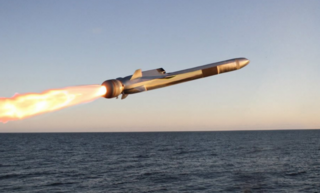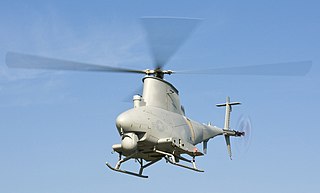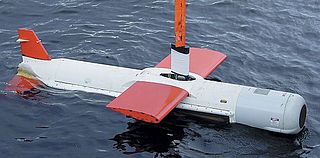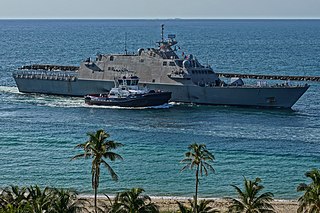
A littoral combat ship (LCS) is either of two classes of relatively small surface vessels designed for operations near shore by the United States Navy. It was "envisioned to be a networked, agile, stealthy surface combatant capable of defeating anti-access and asymmetric threats in the littorals", although their ability to perform these missions in practice has been called into question.

USS Freedom (LCS-1) is the lead ship of the Freedom-class littoral combat ship for the United States Navy. She is the third vessel to be so named after the concept of freedom. She is the design competitor produced by the Lockheed Martin consortium, in competition with the General Dynamics–designed USS Independence. She was officially accepted by the Supervisor of Shipbuilding Gulf Coast, on behalf of the US Navy, from the Lockheed Martin/Marinette Marine/Gibbs and Cox team, in Marinette, Wisconsin, on 18 September 2008.

The Naval Strike Missile (NSM) is an anti-ship and land-attack missile developed by the Norwegian company Kongsberg Defence & Aerospace (KDA).

The Northrop Grumman MQ-8 Fire Scout is an unmanned autonomous helicopter developed by Northrop Grumman for use by the United States Armed Forces. The Fire Scout is designed to provide reconnaissance, situational awareness, aerial fire support and precision targeting support for ground, air and sea forces. The initial RQ-8A version was based on the Schweizer 330, while the enhanced MQ-8B was derived from the Schweizer 333. The larger MQ-8C Fire Scout variant is based on the Bell 407.

USS Independence (LCS-2) is the lead ship of the Independence-class of littoral combat ships. She is the sixth ship of the United States Navy to be named for the concept of independence. The design was produced by the General Dynamics consortium for the Navy's LCS program, and competes with the Lockheed Martin designed Freedom variant.
Lockheed Martin Rotary and Mission Systems (LM RMS), is a Lockheed Martin business segment headquartered in Washington, D.C. Until October 2008, RMS was headquartered in Moorestown Township, New Jersey, a suburb of Philadelphia; Moorestown remains one of the largest sites in the business unit and is where many of the unit's top executives have their offices.

The AQS-20A is a sonar mine countermeasure detection system, developed by Raytheon. The system was initially tested for use on the MH-60S and MH-53E helicopters and as part of the mission package for the littoral combat ships (LCS) and some United States Navy destroyers of the Arleigh Burke class. However, the Chief of Naval Operations excluded the system from use on helicopter assets in March 2012, and only one destroyer has been outfitted with the specific mission package as of April 2009. The AN/AQS-20 naval mine hunting sonar systems will be employed for deeper mine threats. The "Q-20", as it is commonly called, is an underwater towed body containing a high resolution, side-looking, multi-beam sonar system used for minehunting along the ocean bottom. This rapidly deployable system provides real-time sonar images to operators to locate, classify, mark and record mine-like objects and underwater terrain features. The AQS-20 has an active, stabilized underwater vehicle, equipped with advanced multiple-beam side-looking sonar. The underwater body is towed via a small-diameter electromechanical cable, while an operator can view the underwater image and identify objects on a video monitor while recording the data on S-VHS digital tapes for post mission analysis. Operators actually "fly" the device underwater, controlling the depth of the device the same way that an airplane controls its altitude. Once located, the exact coordinates of mine-like objects can be used by explosive ordnance disposal (EOD) personnel to reacquire and neutralize the mine.

USS Bainbridge (DDG-96) is an Arleigh Burke-class guided missile destroyer in the United States Navy. She is the fifth ship to carry that name, and the 46th destroyer of a planned 75-ship class. Bainbridge is named in honor of Commodore William Bainbridge, who as commander of the frigate USS Constitution distinguished himself in the War of 1812 when he and his crew captured HMS Java, a 38-gun fifth-rate frigate of the Royal Navy.

The Independence class is a class of littoral combat ships built for the United States Navy.

The Freedom class is one of two classes of the littoral combat ship program, built for the United States Navy.

USS Fort Worth (LCS-3) is a Freedom-class littoral combat ship of the United States Navy. She is the first ship to be named after Fort Worth, Texas, the 13th-largest city in the United States.

USS Coronado (LCS-4) is an Independence-class littoral combat ship. She is the third ship of the United States Navy to be named after Coronado, California.

USS Milwaukee (LCS-5) was a Freedom-class littoral combat ship of the United States Navy. She was the fifth ship to be named for the city of Milwaukee, the largest city in Wisconsin.

USS Detroit (LCS-7) is the fourth Freedom-class littoral combat ship of the United States Navy. She is the sixth ship to be named after the city of Detroit, Michigan.

USS Little Rock (LCS-9) was a Freedom-class littoral combat ship (LCS) of the United States Navy. She is the second ship named after Little Rock, the capital city of Arkansas.

USS Sioux City (LCS-11) was a Freedom-class littoral combat ship of the United States Navy. She is the first ship named after Sioux City, the fourth-largest city in Iowa.

The Fleet-class unmanned surface vessel, also called the Common Unmanned Surface Vessel (CUSV) and later the Mine Countermeasures Unmanned Surface Vehicle, is an unmanned surface vessel designed for the United States Navy to be deployed from Freedom and Independence-class littoral combat ships and intended to conduct mine and anti-submarine warfare missions. As of 2012 four units of the class have been built; the first was delivered to the U.S. Navy in 2008.
The Knifefish is an autonomous unmanned underwater vehicle (UUV) under development by General Dynamics Mission Systems and Bluefin Robotics for the United States Navy. It is a propeller-driven minesweeping robot designed to replace the Navy's trained dolphins and sea lions after the retirement of the 50-year-old Marine Mammal Program in 2017. The Knifefish was first unveiled at a Navy exposition in April 2012, and was originally intended to operate in concert with the Navy's littoral combat ships (LCS) as part of a specialized counter-mine system.

The Northrop Grumman MQ-8C Fire Scout is an unmanned helicopter developed by Northrop Grumman for use by the United States Navy. The MQ-8C also has autonomous take-off and landing capability. It is designed to provide reconnaissance, situational awareness, aerial fire support and precision targeting support for ground, air and sea forces. The MQ-8C airframe is based on the Bell 407, while the avionics and other systems are developed from those used on the MQ-8B Fire Scout. It first flew in October 2013 and achieved initial operational capability on 28 June 2019.

USS Marinette (LCS-25) is a Freedom-class littoral combat ship of the United States Navy. She is the first commissioned ship, and second overall in naval service to be named after Marinette, Wisconsin, the other being Marinette (YTB-791), a Natick-class large fleet tugboat.
















